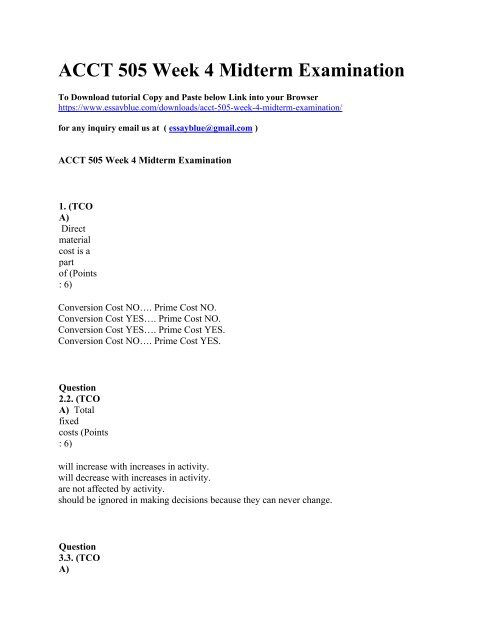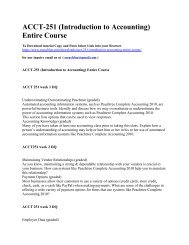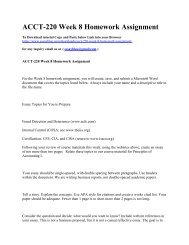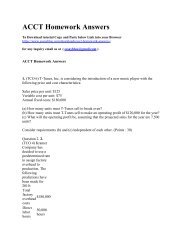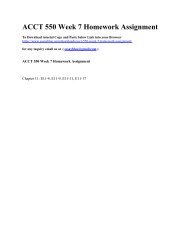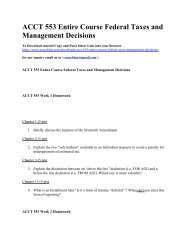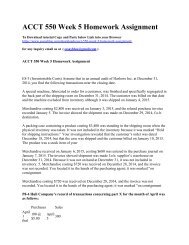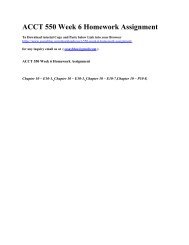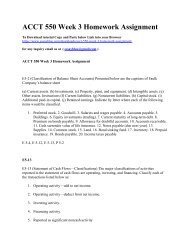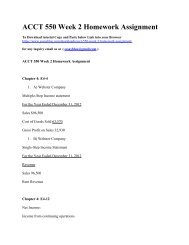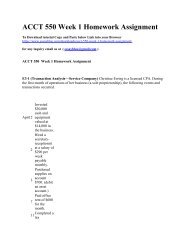ACCT 505 Week 4 Midterm Examination
Create successful ePaper yourself
Turn your PDF publications into a flip-book with our unique Google optimized e-Paper software.
<strong>ACCT</strong> <strong>505</strong> <strong>Week</strong> 4 <strong>Midterm</strong> <strong>Examination</strong><br />
To Download tutorial Copy and Paste below Link into your Browser<br />
https://www.essayblue.com/downloads/acct-<strong>505</strong>-week-4-midterm-examination/<br />
for any inquiry email us at ( essayblue@gmail.com )<br />
<strong>ACCT</strong> <strong>505</strong> <strong>Week</strong> 4 <strong>Midterm</strong> <strong>Examination</strong><br />
1. (TCO<br />
A)<br />
Direct<br />
material<br />
cost is a<br />
part<br />
of (Points<br />
: 6)<br />
Conversion Cost NO…. Prime Cost NO.<br />
Conversion Cost YES…. Prime Cost NO.<br />
Conversion Cost YES…. Prime Cost YES.<br />
Conversion Cost NO…. Prime Cost YES.<br />
Question<br />
2.2. (TCO<br />
A) Total<br />
fixed<br />
costs (Points<br />
: 6)<br />
will increase with increases in activity.<br />
will decrease with increases in activity.<br />
are not affected by activity.<br />
should be ignored in making decisions because they can never change.<br />
Question<br />
3.3. (TCO<br />
A)
Property<br />
taxes on a<br />
company’s<br />
factory<br />
building<br />
would be<br />
classified<br />
as<br />
a(n) (Points<br />
: 6)<br />
variable cost.<br />
opportunity cost.<br />
period cost.<br />
product cost.<br />
Question<br />
4.4. (TCO C)<br />
When the activity<br />
level is expected<br />
to increase within<br />
the relevant range,<br />
what effects<br />
would be<br />
anticipated with<br />
respect to each of<br />
the<br />
following? (Points<br />
: 6)<br />
Fixed costs per unit decrease and variable costs per unit do not change.<br />
Fixed costs per unit increase and variable costs per unit do not change.<br />
Fixed costs per unit do not change and variable costs per unit do not change.<br />
Fixed costs per unit do not change and variable costs per unit increase.<br />
Question<br />
5.5. (TCO B)<br />
Which of the<br />
following<br />
statements is<br />
true?<br />
I. Overhead
application may<br />
be made slowly<br />
as a job is worked<br />
on.<br />
II. Overhead<br />
application may<br />
be made in a<br />
single application<br />
at the time of<br />
completion of the<br />
job.<br />
III. Overhead<br />
application<br />
should be made<br />
to any job not<br />
completed at year<br />
end in order to<br />
properly value<br />
the work in<br />
process<br />
inventory. (Points<br />
: 6)<br />
Only statement I is true.<br />
Only statement II is true.<br />
Both statements I and II are true.<br />
Statements I, II, and III are true.<br />
Question 6.6. (TCO<br />
B) Under a job-order<br />
costing system, the<br />
product being<br />
manufactured (Points<br />
: 6)<br />
is homogeneous.<br />
passes from one manufacturing department to the next before being completed.<br />
can be custom manufactured.<br />
has a unit cost that is easy to calculate by dividing total production costs by the units produced.<br />
Question<br />
7.7. (TCO
F) Equivalent<br />
units for a<br />
process<br />
costing<br />
system using<br />
the FIFO<br />
method would<br />
be equal<br />
to (Points : 6)<br />
units completed during the period, plus equivalent units in the ending work-in-process inventory.<br />
units started and completed during the period, plus equivalent units in the ending work-inprocess<br />
inventory.<br />
units completed during the period and transferred out.<br />
units started and completed during the period, plus equivalent units in the ending work-inprocess<br />
inventory, plus work needed to complete units in the beginning work-in-process<br />
inventory.<br />
Question<br />
8.8. (TCO C)<br />
The<br />
contribution<br />
margin<br />
equals (Points<br />
: 6)<br />
sales – expenses.<br />
sales – variable costs.<br />
sales – cost of goods sold.<br />
sales – fixed costs.<br />
Question<br />
9.9. (TCO<br />
C) Which of<br />
the following<br />
would not<br />
affect the<br />
break-even<br />
point? (Points<br />
: 6)<br />
Variable expense per unit
Number of units sold<br />
Total fixed expenses<br />
Selling price per unit<br />
Question<br />
10.10. (TCO<br />
D) Under<br />
variable<br />
costing, (Points<br />
: 6)<br />
inventory costs will be lower than under absorption costing.<br />
inventory costs will be higher than under absorption costing.<br />
net operating income will always be lower than under absorption costing.<br />
net operating income will always be higher than under absorption costing.<br />
1. (TCO A) The following data (in thousands of dollars) have been taken from the<br />
accounting records of Larop Corporation for the just-completed year.<br />
Sales $950<br />
Purchases of raw<br />
materials<br />
$225<br />
Direct labor $250<br />
Manufacturing<br />
overhead<br />
$295<br />
Administrative<br />
expenses<br />
$150<br />
Selling expenses $140<br />
Raw materials<br />
inventory, beginning $30<br />
Raw materials<br />
inventory, ending<br />
$45<br />
Work-in-process<br />
inventory, beginning $20<br />
Work-in-process<br />
inventory, ending<br />
$55<br />
Finished goods<br />
inventory, beginning $100<br />
Finished goods<br />
inventory, ending<br />
$135<br />
Prepare a Schedule of Cost of Goods Manufactured statement in the text box below. (Points : 15)
Question 2.2. (TCO B) The Nebraska Company manufactures a product that goes through three<br />
processing departments. Information relating to activity in the first department during June is<br />
given below.<br />
Percentage<br />
Completed<br />
Units Materials Conversion<br />
Work in process, June<br />
140,000 65% 45%<br />
1<br />
Work in process, Jun<br />
120,000 75% 65%<br />
30<br />
The department started 580,000 units into production during the month and transferred 600,000<br />
completed units to the next department.<br />
Required: Compute the equivalent units of production for the first department for June,<br />
assuming that the company uses the weighted-average method of accounting for units and<br />
costs.(Points : 20)<br />
Question 3.3. (TCO C) A tile manufacturer has supplied the following data.<br />
Boxes of tile produced and sold 625,000<br />
Sales revenue $2,975,000<br />
Variable manufacturing expense $1,720,000<br />
Fixed manufacturing expense $790,000<br />
Variable selling and admin expense $152,000<br />
Fixed selling and admin expense $133,000<br />
Net operating income $180,000<br />
Required:<br />
Calculate the company’s unit contribution margin.<br />
Calculate the company’s contribution margin ratio.<br />
If the company increases its unit sales volume by 5% without increasing its fixed expenses, what<br />
would the company’s net operating income be? (Points : 25)<br />
Question 4.4. (TCO D) The Hampton Company produces and sells a single product. The<br />
following data refer to the year just completed.
Selling price $450<br />
Units in beginning<br />
inventory<br />
0<br />
Units produced 25,000<br />
Units sold 22,000<br />
Variable costs per unit:<br />
Direct materials $150<br />
Direct labor $75<br />
Variable manufacturing<br />
overhead<br />
$25<br />
Variable selling and<br />
admin<br />
$15<br />
Fixed costs:<br />
Fixed manufacturing<br />
overhead<br />
$275,000<br />
Fixed selling and admin $200,000<br />
Required:<br />
Compute the cost of a single unit of product under both the absorption costing and variable<br />
costing approaches.<br />
Prepare an income statement for the year using absorption costing.<br />
Prepare an income statement for the year using variable costing. (Points : 30)


